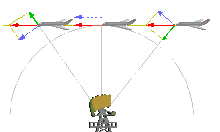
Back Radiale snelheid Afrikaans سرعة شعاعية Arabic سرعه شعاعيه ARZ Velocidá radial AST Радиална скорост Bulgarian Radijalna brzina BS Velocitat radial Catalan Radiální rychlost Czech Radialgeschwindigkeit German Ακτινική ταχύτητα Greek

The radial velocity or line-of-sight velocity of a target with respect to an observer is the rate of change of the vector displacement between the two points. It is formulated as the vector projection of the target-observer relative velocity onto the relative direction or line-of-sight (LOS) connecting the two points.
The radial speed or range rate is the temporal rate of the distance or range between the two points. It is a signed scalar quantity, formulated as the scalar projection of the relative velocity vector onto the LOS direction. Equivalently, radial speed equals the norm of the radial velocity, modulo the sign.[a]
In astronomy, the point is usually taken to be the observer on Earth, so the radial velocity then denotes the speed with which the object moves away from the Earth (or approaches it, for a negative radial velocity).
Cite error: There are <ref group=lower-alpha> tags or {{efn}} templates on this page, but the references will not show without a {{reflist|group=lower-alpha}} template or {{notelist}} template (see the help page).